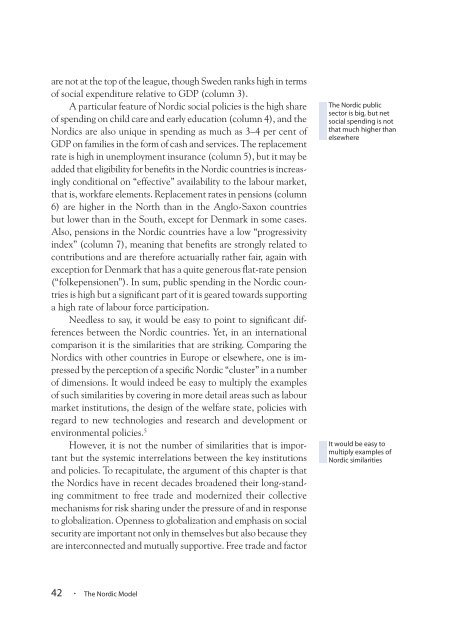The Nordic Model - Embracing globalization and sharing risks
The Nordic Model - Embracing globalization and sharing risks
The Nordic Model - Embracing globalization and sharing risks
You also want an ePaper? Increase the reach of your titles
YUMPU automatically turns print PDFs into web optimized ePapers that Google loves.
are not at the top of the league, though Sweden ranks high in terms<br />
of social expenditure relative to GDP (column 3).<br />
A particular feature of <strong>Nordic</strong> social policies is the high share<br />
of spending on child care <strong>and</strong> early education (column 4), <strong>and</strong> the<br />
<strong>Nordic</strong>s are also unique in spending as much as 3–4 per cent of<br />
GDP on families in the form of cash <strong>and</strong> services. <strong>The</strong> replacement<br />
rate is high in unemployment insurance (column 5), but it may be<br />
added that eligibility for benefits in the <strong>Nordic</strong> countries is increasingly<br />
conditional on “effective” availability to the labour market,<br />
that is, workfare elements. Replacement rates in pensions (column<br />
6) are higher in the North than in the Anglo-Saxon countries<br />
but lower than in the South, except for Denmark in some cases.<br />
Also, pensions in the <strong>Nordic</strong> countries have a low “progressivity<br />
index” (column 7), meaning that benefits are strongly related to<br />
contributions <strong>and</strong> are therefore actuarially rather fair, again with<br />
exception for Denmark that has a quite generous flat-rate pension<br />
(“folkepensionen”). In sum, public spending in the <strong>Nordic</strong> countries<br />
is high but a significant part of it is geared towards supporting<br />
a high rate of labour force participation.<br />
Needless to say, it would be easy to point to significant differences<br />
between the <strong>Nordic</strong> countries. Yet, in an international<br />
comparison it is the similarities that are striking. Comparing the<br />
<strong>Nordic</strong>s with other countries in Europe or elsewhere, one is impressed<br />
by the perception of a specific <strong>Nordic</strong> “cluster” in a number<br />
of dimensions. It would indeed be easy to multiply the examples<br />
of such similarities by covering in more detail areas such as labour<br />
market institutions, the design of the welfare state, policies with<br />
regard to new technologies <strong>and</strong> research <strong>and</strong> development or<br />
environmental policies. 5<br />
However, it is not the number of similarities that is important<br />
but the systemic interrelations between the key institutions<br />
<strong>and</strong> policies. To recapitulate, the argument of this chapter is that<br />
the <strong>Nordic</strong>s have in recent decades broadened their long-st<strong>and</strong>ing<br />
commitment to free trade <strong>and</strong> modernized their collective<br />
mechanisms for risk <strong>sharing</strong> under the pressure of <strong>and</strong> in response<br />
to <strong>globalization</strong>. Openness to <strong>globalization</strong> <strong>and</strong> emphasis on social<br />
security are important not only in themselves but also because they<br />
are interconnected <strong>and</strong> mutually supportive. Free trade <strong>and</strong> factor<br />
<strong>The</strong> <strong>Nordic</strong> public<br />
sector is big, but net<br />
social spending is not<br />
that much higher than<br />
elsewhere<br />
It would be easy to<br />
multiply examples of<br />
<strong>Nordic</strong> similarities<br />
42 · <strong>The</strong> <strong>Nordic</strong> <strong>Model</strong>

















